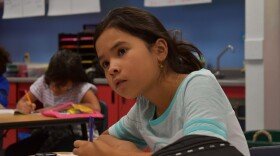For many Latinos around the world, Friday is the start of a two-day holiday: Día de los Muertos or Day of the Dead. It’s a celebration to welcome back loved ones who have passed in order to reunite with the living. University of Nevada, Reno Senior Gabino Salinas is a first-generation Mexican-American and is celebrating the holiday for the first time. KUNR’s Stephanie Serrano spoke to him about his experience.
This weekend there will be several Día de los Muertos celebrations hosted by different organizations in our region. The Latino Research Center, The Holland Project, Reno Little Theater, The Jesse Reno, and the Nevada State Museum are all hosting events.

KUNR: Did you grow up celebrating Día de los Muertos?
Salinas: I actually did not. I did a lot of research for it, I had an idea of what it was and I knew that it was a really cool thing. I grew up celebrating Halloween. My parents never taught us how to celebrate Día de los Muertos, so learning about it and realizing just how beautiful it is because it does connect you with you relatives that have passed away or people that have passed away and it's nice to commemorate them.
What did you learn from your research?
You build the altar in tiers, and each tier has a different significance, so one is the underworld, ground level, and the spirit world is the top tier. It all depends on what your culture does because it is all regional and it predates the arrival of Spanish colonizers. It definitely is an indigenous holiday. Different cultures really commit to it, like, some people they'll spend the night at their relative's tombstone. I think it's a nice idea that you get to engage with these spirits that you love or care for.
What kind of items would you set on an altar to welcome back your loved ones?
Food for sure, water is a must, you're supposed to put salt in it for purity, their picture, and candles because they'll guide the way. These items welcome them--dale la bienvenidad--greet them with the things that they are familiar with and the things that make them happy, so upon their arrival they'll think, 'oh, nice, these are the toys that I loved.'
Tell me about the altar that you made this year at the university.
I'm with the Spanish Club; I'm the president. We worked with the Latino Student Advisory Board in order to come up with the idea surrounding the southern border. I know a couple of kids passed away upon their arrival to the border. I wanted to pay respect to these people because they experienced a lot of hardships, and then, unfortunately, didn't get to experience any of the benefits.
We chose six kids, five of them are from Guatemala and one from El Salvador. The kids we chose had been in Customs and Border Patrol or recently released from their custody. We have their pictures up, labels with their names, age, age of death and the country they were from. We also created an abstract that talks about mistreatment of people who come to the border seeking asylum. The altar has toys, bread and decorated porcelain skull heads.
You had a brother who passed away. If you were to add him to an altar, what items would you choose to welcome him back?
Soccer gloves--he was a soccer goalie all of his life. He moved to Mexico to pursue a career in soccer, and he liked music, so maybe like a Kanye West album. He always listened to him.







